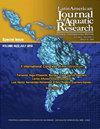Metabolic and osmoionic effects of the recombinant crustacean hyperglycemic hormone (rCHH-A) of the Pacific white shrimp Penaeus vannamei on specimens acutely exposed to extreme salinities
IF 0.8
4区 农林科学
Q3 FISHERIES
Latin American Journal of Aquatic Research
Pub Date : 2023-04-30
DOI:10.3856/vol51-issue2-fulltext-2967
引用次数: 0
Abstract
The crustacean hyperglycemic hormone (CHH) is a multifunctional neuropeptide that plays a central role in crustacean metabolism and physiology. Experiments were conducted to examine the metabolic and osmoionic capabilities of the white shrimp Penaeus vannamei injected with its recombinant CHH-A (rCHH-A) peptide and acutely transferred from iso- (26 ppt) to hypo- (10 ppt) and hyper-osmotic (40 ppt) conditions. Hemolymph glucose, protein, osmoregulatory capacity (OC), and ionoregulatory capacity (IC) for sodium, chloride, potassium, and calcium were evaluated at four post-injection times (0.5, 1, 2, and 24 h). The rCHH-A peptide had hyperglycemic activity in all salinity conditions, obtaining maximum values at 1 h post-injection. However, in shrimp transferred to hyper-osmotic condition, rCHH-A caused the most significant reductions in OC (2 h), chloride IC (2 h), and total proteins (0.5-2 h) compared to the phosphate-buffered saline (PBS) control. Contrastingly, in shrimp transferred to hypo-osmotic conditions, rCHH-A decreased OC significantly from 2-24 h, strongly decreased chloride and potassium IC at 1 h post-injection, and increased total protein concentration in the hemolymph (1-2 h) when compared to PBS control. Concerning calcium, the rCHH-A injection decreased calcium IC at 10 ppt (1 h) and 26 ppt (2 h), providing insight into a potential role for CHH-A in calcium regulation. The results suggest that glucose and protein mobilization could enhance energy for osmo-ionic regulation under extreme osmotic conditions. This research study contributed to understanding crustacean endocrinology in P. vannamei and related euryhaline crustaceans. Further research should be performed to understand the osmo- and ionoregulatory mechanisms of the different CHH variants in crustaceans exposed to other stress conditions and the relationship with intermediary energy metabolism regulation.太平洋南美白对虾重组甲壳类动物高血糖激素(rCHH-A)对极端盐度标本的代谢和渗透作用
甲壳类动物高血糖激素(CHH)是一种多功能神经肽,在甲壳类生物的代谢和生理中起着核心作用。实验检测了用其重组CHH-A(rCHH-A)肽注射并从等-(26ppt)条件急性转移到低-(10ppt)和高渗(40ppt)状态的南美白对虾的代谢和渗透能力。在注射后的四个时间(0.5、1、2和24小时)评估血淋巴葡萄糖、蛋白质、渗透调节能力(OC)和对钠、氯、钾和钙的离子调节能力(IC)。rCHH-A肽在所有盐度条件下都具有高血糖活性,在注射后1小时获得最大值。然而,在转移到高渗条件下的虾中,与磷酸盐缓冲盐水(PBS)对照相比,rCHH-A引起OC(2小时)、氯离子IC(2 h)和总蛋白(0.5-2 h)的最显著降低。相反,在转移到低渗透条件下的虾中,与PBS对照相比,rCHH-A在2-24小时显著降低OC,在注射后1小时显著降低氯化物和钾IC,并增加血淋巴中的总蛋白浓度(1-2小时)。关于钙,rCHH-A注射在10ppt(1小时)和26ppt(2小时)时降低了钙IC,从而深入了解了CHH-A在钙调节中的潜在作用。结果表明,在极端渗透条件下,葡萄糖和蛋白质动员可以增强渗透离子调节的能量。这项研究有助于了解凡纳滨对虾和相关的广盐甲壳类动物的甲壳类生物内分泌学。应进行进一步的研究,以了解暴露于其他应激条件的甲壳类动物中不同CHH变体的渗透和离子调节机制,以及与中间能量代谢调节的关系。
本文章由计算机程序翻译,如有差异,请以英文原文为准。
求助全文
约1分钟内获得全文
求助全文
来源期刊

Latin American Journal of Aquatic Research
FISHERIES-MARINE & FRESHWATER BIOLOGY
CiteScore
1.70
自引率
10.00%
发文量
44
审稿时长
4-8 weeks
期刊介绍:
Latin American Journal of Aquatic Research- LAJAR is the continuation of the journal Investigaciones Marinas (1970-2007) and is published since 2008 by the Escuela de Ciencias del Mar, Facultad de Ciencias del Mar y Geografía of the Pontificia Universidad Católica de Valparaíso. LAJAR is an “Open Access” journal that publishes in English language, original research articles, reviews and short communications on aquatic science, which contain the results of research conducted in aquaculture or in oceanic and coastal marine waters of Latin America.
The following topics are considered: Physical Oceanography, Chemical Oceanography, Marine Biogeochemistry, Marine Pollution and Toxicology, Marine Geology and Geophysics, Biological Oceanography, Fisheries and Aquaculture.
 求助内容:
求助内容: 应助结果提醒方式:
应助结果提醒方式:


